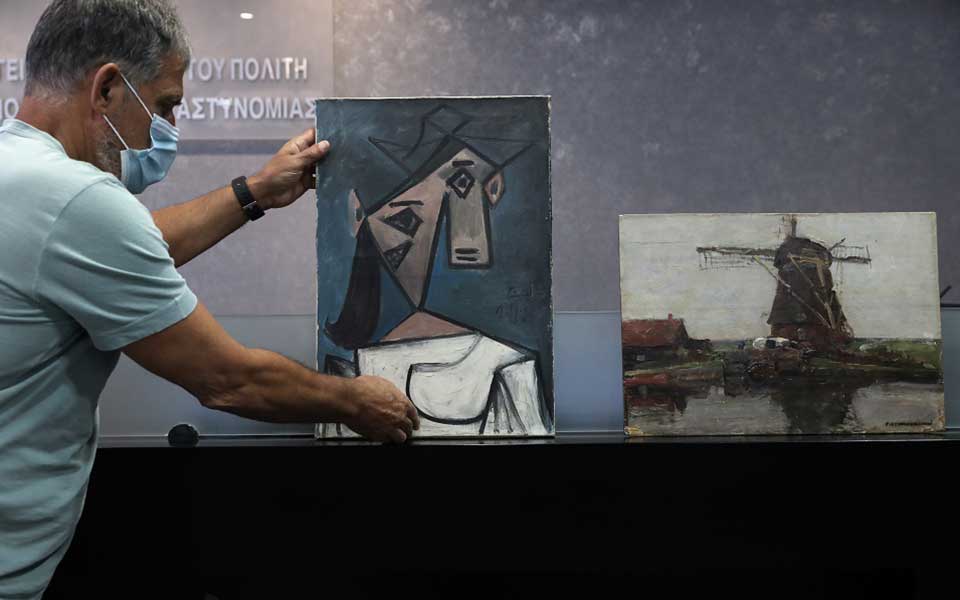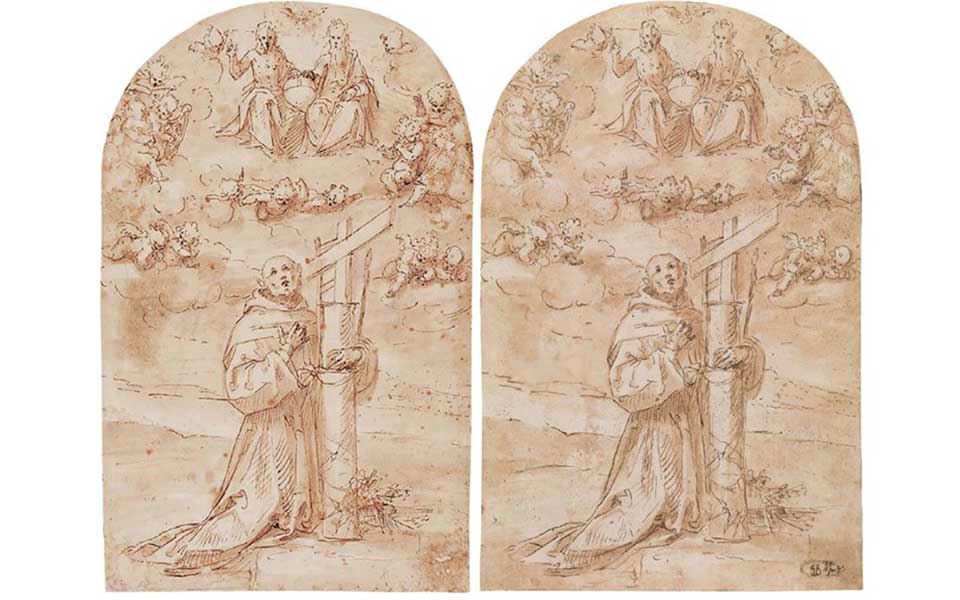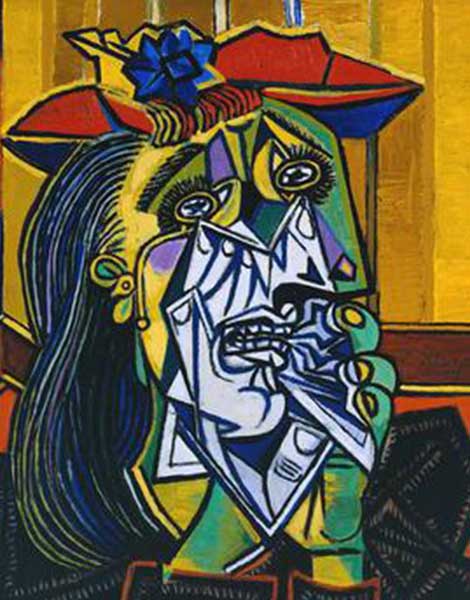Ippokratous and Asklipiou: Two Streets, Infinite Microcosms
Discover a vibrant neighborhood where nightlife,...

Pablo Picasso’s "Head of a Woman" (left) and Piet Mondrian’s "Stammer Windmill" are displayed for the media during a press conference at the police’s Athens headquarters.
© Yiannis Liakos/InTime News
Nine years after the Greek National Gallery fell victim to the “theft of the century,” the crime remains cloaked behind a veil of mystery, only partially unraveled. Crucial answers appear to lie in the triangle of the Netherlands – Greece – England, in the professional and multifaceted operation of the 49-year-old who was arrested and charged with theft, and behind the curtains of a 2019 auction in Florence, Italy.
The 49-year-old is custody pending trial and until he appears in court, the case’s investigator will have enough time to conduct expert analyses of the recovered artworks. As stated by the relevant provisions, the valuation of the works will determine the subsequent criminal proceedings.
According to police authorities, the perpetrator is a painter, working mainly at construction sites. However, his LinkedIn profile, which has since been deactivated, indicated that he also worked at large warehouses outside of Greece. On Twitter, where he went by the handle “ArtFreak,” the 49-year-old frequently posted photos from England and the Netherlands, and appeared to be a Picasso enthusiast. This account has also been shut down.
The authorities reported that they managed to track down the suspect of the January 2012 robbery in the two months prior to his arrest in June. In previous years their investigations led to multiple countries including Serbia and Switzerland, and focused on gallery owners and individuals who had previously been involved in the antiquities market, but to no avail. During the preliminary investigation, the 49-year-old allegedly stated: “I was moving between Greece, the Netherlands and England… At one point I confessed to a girl in England with whom I had a relationship that I had the paintings, but she didn’t take notice of what I had said.”
It was dawn, on January 9, 2012, when the perpetrator entered the National Gallery through an unsecured balcony door. By triggering repeated false alarms, he managed to deceive the guard and reach the paintings. He grabbed them and made his way to a staircase leading to the basement, where he sat and removed them from their frames using a pocket knife. According to one account, a second person tasked with keeping watch had been involved in the operation. The detainee maintains that he acted alone.
This infamous burglary deprived the National Gallery’s permanent collection of three invaluable exhibits, Pablo Picasso’s “Head of a Woman,” Piet Mondrian’s “Stammer Windmill” and 16th-century Italian artist Guglielmo Caccia’s (il Moncalvo) pen and sepia wash drawing “St Diego de Alcala in Ecstasy with the Holy Trinity and the Symbols of Passion.”

A picture of the original work by Italian artist Guglielmo Caccia that was stolen from the National Gallery in Athens (left). An image of the sketch that appeared in the online catalogue of the Pandolfini auction house (right).
According to the police, the 49-year-old had been accused of shoplifting at a young age, but his criminal record did not include any incidents concerning artworks. He allegedly confessed watching the National Gallery on a daily basis for almost six months to identify potential entry points and learn the guards’ habits.
Among the stolen paintings, the painting by Picasso was the most important, as, on top of its artistic value, it is also of special historical and emotional significance for Greece. Picasso did the painting in 1939 and gifted it to the Greek people following the end of World War II as a tribute to their resistance during the Nazi occupation. In fact, on the back of the painting one can find the handwritten dedication, “Pour le peuple Grec. Hommage de Picasso,” 14/10/1939.
Picasso’s “Head of a Woman” was first exhibited to the public in 1949, at the French Institute in Athens. It was part of “Donation by French Artists,” as the collection was later named, and comprised 28 paintings, six drawings, six engravings, four sculptures and two books, offered by famous artists including Picasso, Matisse, Bonnard and Picabia. The exhibition, organized by Roger and Tatiana Milliex, was intended to show France’s support and solidarity for Greece, which was slowly recovering from the painful postwar years.
According to National Gallery curator Zina Kaloudi, “Head of a Woman” is a portrait of French photographer Dora Maar, Picasso’s companion between 1936 and 1943. The curator’s opinion is confirmed by one of Maar’s photos dating 1940, in which the painting is present. The photo was taken at the studio in Rouen where she and Picasso took refuge during the Nazi occupation of Paris.

"Head of a Woman" by Pablo Picasso (1939). On the back of the painting, a handwritten dedication of the Spanish painter states: “Pour le peuple grec, hommage de Picasso” (For the Greek people, tribute from Picasso).

"The Weeping Woman" (1937), on display at the Tate Modern, London.
© Tate - http://www.tate.org.uk/art/images/work/T/T05/T05010_10.jpg
Maar is the photographer who immortalized the creative process behind Picasso’s “Guernica” (1937) and was his model for “The Weeping Woman.” Over three decades passed before the donation of works, and Picasso’s painting, were presented again to the public, in 1980. It remained on display to the public for a long time before returning to its storage room. It re-emerged for one month in the summer of 2007, when the National Gallery displayed the donation in order to celebrate the French Institute’s centenary. The next and last public showing of the portrait was in October, 2011, during “In the Sanctuary of the National Gallery,” which included over 200 works by notable foreign and Greek artists. The exhibition ended in 2012 as the National Gallery prepared to close for renovation and expansion works. But as the then director, Marina Lambraki-Plaka, had commented, the last exhibition would be a foretaste of the museum’s permanent collection following the relaunch, which included many of the same artworks.
The two oil paintings by Piet Mondrian held by the National Gallery are from the Dutch artist’s earlier period, both dating to 1905. Depicting a typical Dutch farm near Amsterdam and the Stammer windmill on the Weesper canal, they foreshadow the artist’s later transition from expressionism to abstract art, a style that he would help pioneer. The latter work was purchased in 1963 by Alexandros Pappas, who subsequently donated it to the National Gallery.
The fate of the Moncalvo drawing remains unknown. The man arrested for the National Gallery theft claims to have destroyed it, allegedly using it to wipe his bloody hand while escaping the gallery, only to hastily stuff it in his pocket and then flush it down the toilet to erase any evidence. In September 2019, an almost identical drawing showed up in the online catalogue of a Florentine auction house. The listing was removed as soon as questions were asked regarding the drawing’s provenance.
Discover a vibrant neighborhood where nightlife,...
Igor Borisov turned Kimolos into his...
Six Athenians tell us about their...
Flirtation, romance, poignance, eroticism, domestic bliss...